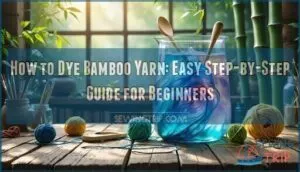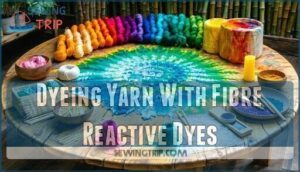This site is supported by our readers. We may earn a commission, at no cost to you, if you purchase through links.
 You can dye bamboo yarn using fiber reactive dyes and the same techniques for cotton, but treat it gently since wet bamboo weakens substantially.
You can dye bamboo yarn using fiber reactive dyes and the same techniques for cotton, but treat it gently since wet bamboo weakens substantially.
Start by soaking your skein in warm water, then prepare your dye bath with cool to lukewarm temperatures—never hot, which damages bamboo fibers.
Mix your dye according to package instructions, immerse the yarn gradually, and stir carefully to avoid breakage.
The process takes patience since bamboo absorbs color differently than other fibers, sometimes creating beautiful and unexpected variations.
While it requires extra care, the silky results make every gentle step worthwhile, as mastering the temperature balance reveals bamboo’s true dyeing potential.
Table Of Contents
Key Takeaways
- Handle bamboo gently when wet – You’ll need to avoid wringing or twisting, since wet bamboo weakens substantially and can break easily during the dyeing process.
- Use cool to lukewarm temperatures only – You should never use hot water, as it damages bamboo fibers; stick to 100-105°F for optimal dye penetration without fiber damage.
- Pre-wash and prep your yarn thoroughly – You’ll get better color results by removing factory residues and oils that block dye absorption, then soaking for 30 minutes before dyeing.
- Choose fiber-reactive dyes with proper fixatives – You’ll achieve vibrant, long-lasting colors by using sodium carbonate or soda ash to chemically bond the dye to bamboo’s cellulose structure.
Supplies
Gather your yarn dyeing supplies before diving into this colorful adventure. You’ll need stainless pots designated for dyeing (never use your cooking ones!), dye containers for mixing solutions, and safety gloves to protect your hands.
Fiber dyes work best on bamboo yarn—choose fiber reactive types for vibrant, lasting colors. Don’t forget protective masks when handling dye powders, as breathing protection matters.
Cover your workspace with plastic sheeting because bamboo yarn dyeing can get messy. These dyeing bamboo yarn essentials and natural yarn dye materials will set you up for success in mastering various yarn dyeing techniques.
For a successful project, consider investing in high-quality sewing supplies online to guarantee your tools are durable and efficient.
Step 1: Preparing The Fiber
Proper fiber preparation sets the foundation for vibrant, long-lasting color results when dyeing bamboo yarn. Your bamboo yarn likely contains factory residues, oils, and sizing agents that create barriers between the dye and fiber molecules. Think of it like trying to paint a greasy surface—the color won’t stick properly without thorough cleaning first.
Clean fibers are the secret to stunning, even color absorption.
Here’s your fiber cleaning checklist:
- Pre-wash skeins in lukewarm water (under 40°C) with mild plant-fiber detergent to remove manufacturing residues
- Rinse thoroughly under running water until no soap suds remain visible
- Soak prepared yarn in warm water for 30 minutes minimum to open fiber structure for better dye absorption
- Tie skeins loosely at multiple points to prevent tangling during subsequent dyeing processes
Gentle squeezing removes excess water—never wring or twist bamboo fibers. This yarn preparation stage directly impacts your final color intensity and evenness. Natural yarn dye techniques require clean, receptive fibers for superior results.
Proper skein management and fiber treatment create the ideal foundation for successful dyeing bamboo yarn projects. Understanding fabric preparation techniques is vital for achieving the best results in textile crafts.
Step 2: Dyeing Process
Success hinges on proper dye mixing and maintaining consistent dye temperature throughout the bamboo dyeing process.
Heat your dye bath to 100-105°F for ideal dye penetration into bamboo fibers. Add your prepared yarn to the warm solution, ensuring complete yarn soaking for even color distribution.
Stir gently every 10-15 minutes during the hour-long process. For effective color fixing, add sodium carbonate after initial soaking.
These proven yarn dyeing techniques and hand dyeing bamboo methods create vibrant bamboo yarn colors that’ll make your projects shine. Understanding various dyeing techniques is essential for achieving desired colors and patterns, using dyeing techniques for the best results.
Step 3: Rinse and Soak
With your dyeing process complete, you’re ready to lock in those vibrant colors through proper rinsing. Start by running cold water over your bamboo yarn until the water runs completely clear—this yarn rinsing step removes excess dye that didn’t bond with the fibers.
Next, create your vinegar soak by mixing one cup white vinegar with four cups cold water. This color fixing solution helps set the dye while testing colorfastness. Submerge your yarn overnight in this mixture for ideal dye removal of loose particles.
Water temperature matters here—keep it cool to protect your fiber care investment. If you’re after deeper, richer tones, swap the vinegar for saltwater instead. This alternative intensifies certain colors without compromising your bamboo yarn’s integrity throughout the dyeing process. Understanding proper fabric care techniques is essential for maintaining the quality of your yarn after dyeing.
Step 4: Drying The Yarn
Once your bamboo yarn finishes its color-fixing rinse, the drying process becomes vital for preserving both the vibrant hues and the fiber’s integrity. Think of this step as your yarn’s recovery period—rushing it could undo all your careful work. The key lies in patience and proper air drying techniques that protect your investment.
Here’s your roadmap to perfect yarn drying:
- Squeeze gently without wringing to remove excess water while preserving the fiber structure
- Lay flat on clean towels in an even layer, smoothing out any tangles or twists
- Choose shaded locations for air drying to prevent UV damage that fades colors
- Rotate occasionally during the drying process for even moisture evaporation
- Test for complete dryness before storing to prevent mold or mildew issues
Proper fiber care during this stage guarantees your dyeing process yields lasting results. Allow 24-48 hours for complete air drying, depending on humidity levels. Once dry, your yarn storage should protect against direct sunlight and moisture. Mastering sewing skills basics can also enhance your understanding of fabric care and handling.
Dyeing 100% Bamboo Yarn
Once your bamboo yarn is properly dried, you’re ready to tackle specific techniques for 100% bamboo fiber. This natural material responds differently than synthetic fibers, requiring customized approaches for maximum color results.
Key techniques for vibrant bamboo fiber dye results:
- Pre-wet thoroughly – Bamboo’s dense structure needs complete saturation before dye application to prevent patchy absorption
- Maintain 104-122°F water temperature – This range optimizes fiber properties for maximum dye penetration without damage
- Use soda ash fixation – Add 1 tablespoon per gallon to create alkaline conditions that bond dyes permanently to cellulose
- Stir continuously during application – Consistent agitation guarantees even color distribution across all yarn sections
- Apply eco dyes gradually – Natural dye methods work best when colors build slowly through multiple gentle applications
Understanding color theory helps predict how bamboo naturally accepts pigments. The fiber’s smooth surface reflects light beautifully once properly dyed. Mastering various natural dye techniques can enhance the overall dyeing process for beginners.
Dyeing Yarn With Fibre Reactive Dyes
With fibre reactive dyes, you’ll discover vibrant, wash-fast colors that chemically bond with bamboo’s cellulose structure.
These powerhouse dyes require proper yarn preparation—pre-wash and soak your bamboo for maximum absorption.
Master colour theory by mixing primaries to create custom shades.
The reactive dyeing process demands precise pH levels around 10.5 using soda ash for maximum dye fixation.
Temperature control at 20-30°C prevents fiber damage while ensuring complete penetration.
Various yarn dyeing techniques like immersion or hand-painting offer creative freedom in your dyeing process.
Understanding silk dye properties is vital for achieving the best results in fibre reactive dyeing.
Dyeing Over Colored Cotton/Bamboo Blend Yarn Tutorial
Working with pre-dyed cotton/bamboo blends opens up exciting possibilities for color layering and creative expression.
Pre-dyed yarns become your artistic foundation for endless color adventures.
While fiber reactive dyes work best on these cellulose blends, you’ll need to understand how color theory affects your final results. The existing color acts as your canvas—light colors accept new dyes readily, while dark shades resist change. Your bamboo yarn’s blend ratio also impacts dye uptake, with higher bamboo content typically accepting color more evenly than cotton-heavy blends.
Here’s your step-by-step approach:
- Fiber preparation: Pre-wash with mild detergent to remove sizing that blocks dye penetration, then soak in warm water for 30 minutes.
- Overdye techniques: Use immersion dyeing with constant stirring, maintaining 40-60°C temperature for proper dye fixation without damaging fibers.
- Yarn blending strategy: Test small swatches first—your final color combines with the base shade, creating unexpected but often beautiful results.
Understanding the cotton vs bamboo differences is vital for making informed decisions about your yarn choices. Remember, eco friendly dye options work excellently with bamboo yarn, and proper yarn dyeing techniques guarantee lasting color that won’t fade.
Frequently Asked Questions (FAQs)
Does bamboo fabric take dye well?
Surprisingly, bamboo fabric accepts dye beautifully due to its cellulose structure. You’ll achieve vibrant, long-lasting colors using fiber-reactive dyes with proper preparation and technique.
Can you dye bamboo cotton yarn?
You can absolutely dye bamboo cotton yarn blends! Use fiber-reactive dyes like Procion MX for vibrant, permanent results. Pre-wash your yarn, then follow standard cellulose dyeing techniques with proper fixatives.
What are the two methods of dyeing bamboo?
Two primary methods reveal bamboo’s color potential: hot water dyeing creates vibrant, long-lasting hues through heat activation, while cold water dyeing produces softer, gentler tones perfect for delicate projects.
How do you dye bamboo?
Pre-wash bamboo yarn with mild detergent to remove residues.
Soak in warm water for 30 minutes.
Use fiber-reactive dyes with sodium carbonate as fixer.
Maintain consistent temperature while stirring.
Rinse until water runs clear, then air dry completely, ensuring the yarn is fully treated with sodium carbonate.
Can bamboo yarn be dyed multiple colors?
Yes, you can dye bamboo yarn multiple colors using several techniques. Try immersion dyeing different sections, hand-painting with squeeze bottles, or tie-dye methods for variegated effects throughout your yarn.
How long does bamboo dye last?
With proper fixation, quality, and care, bamboo dye lasts years through countless washes.
You’ll maximize longevity by using fiber-reactive dyes, maintaining cool water temperatures, and protecting your vibrant creations from harsh sunlight exposure, which will also help ensure the longevity of your bamboo dye.
What causes bamboo yarn color bleeding?
Color bleeding happens when you don’t rinse thoroughly after dyeing, skip fixatives like vinegar or soda ash, use too much dye, or wash in hot water before colors set properly.
Can you overdye faded bamboo yarn?
Surprisingly, overdyeing faded bamboo yarn works beautifully! You’ll breathe new life into those tired colors. Clean the yarn first, then follow standard fiber-reactive dye processes for vibrant results.
Why did my bamboo yarn turn muddy?
Your bamboo yarn likely turned muddy because you mixed incompatible dye colors, used too much dye, or didn’t rinse thoroughly between color applications, causing unwanted color bleeding and muddiness.
Conclusion
Practice makes perfect when learning how to dye bamboo yarn, and you’ll find each project builds your confidence.
The gentle techniques you’ve mastered protect delicate fibers while achieving vibrant results.
Remember to maintain cool temperatures, handle wet yarn carefully, and embrace the unique color variations bamboo creates.
With patience and the right approach, you’ll consistently produce beautifully dyed bamboo yarn that showcases this fiber’s natural elegance and versatility.











